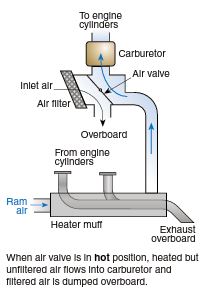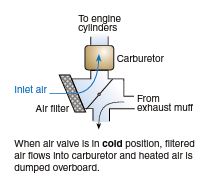Let’s recap some of the important information we learned from Monday’s post on carburetor ice.
As air flows through a carburetor, it expands rapidly. At the same time, fuel entering the airstream is vaporized. Expansion of the air and vaporization of the fuel causes a sudden cooling of the mixture which may cause ice to form inside the carburetor. The possibility of icing should always be considered when operating in conditions where the outside air temperature is between 20°F and 70°F and the relative humidity is high.
Carburetor heat preheats the air before it enters the carburetor and either prevents carburetor ice from forming or melts any ice which may have formed. When heat is applied, unfiltered air enters directly through the ram air inlet. This induction air passes through part of the exhaust system acting as the heating mechanism and continues onto the carburetor. By manipulating the carburetor heat control in the cockpit, you are simply opening or closing an air valve allowing unfiltered heated air in while dumping filtered cold air overboard, and vice versa. You can see this in the figures below.
When carburetor heat is applied, the heated air that enters the carburetor is less dense. This causes the air/fuel mixture to become enriched, and this in turn decreases engine output (less engine horsepower) and increases engine operating temperatures.
Some things to take note of:
- During engine run-up, prior to departure from a high-altitude airport, the pilot may notice a slight engine roughness which is not affected by the magneto check but grows worse during the carburetor heat check. In this case, the air/fuel mixture may be too rich due to the lower air density at the high altitude and applying carburetor heat will decrease the air density even more. A leaner setting of the mixture control may correct this problem.
- In an airplane with a fixed-pitch propeller, the first indication of carburetor ice will likely be a decrease in RPM as the air supply is choked off. Application of carburetor heat will decrease air density, causing the RPM to drop even lower. Then, as the carburetor ice melts, the RPM will rise gradually.
- Fuel injection systems, which do not utilize a carburetor, are generally considered to be less susceptible to icing than carburetor systems are.
Which statement is true concerning the effect of the application of carburetor heat?
A—It enriches the fuel/air mixture.
B—It leans the fuel/air mixture.
C—It has no effect on the fuel/air mixture.
Can you expand on this question and explain to us why? Let us know in the comments section and if you’re correct well give you mad props! (get it?)






